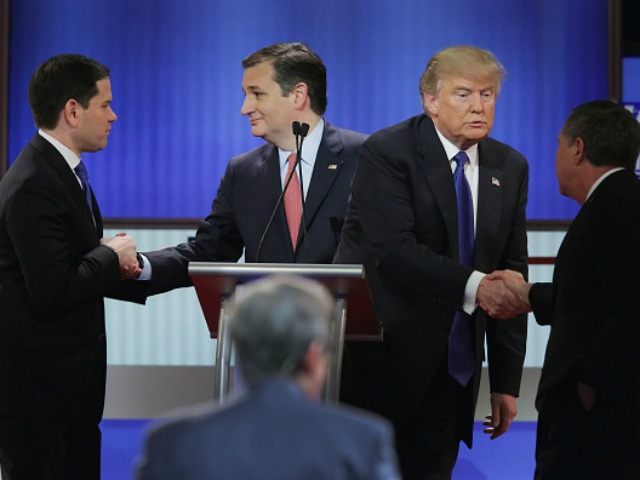The latest poll ahead of the Illinois primary on March 15 shows a four-way knife fight. Donald Trump leads the crowded pack with 32 percent, followed by Ted Cruz at 22, Marco Rubio at 21 and John Kasich with 18 percent.
Trump’s current 10-point lead is down from the 17-point margin he enjoyed at the end of February. Trump’s numbers have dropped a bit, while both Cruz and Kasich have gained support.
This matters, because the downstate area will be a primary battleground for the state’s 69 delegates. Illinois has a very complicated process for awarding delegates. It is possible, in fact, that the candidate with the most votes statewide ends up with fewer delegates than the runner-up.
The winner of the overall statewide vote is awarded 15 delegates. Another 54 delegates are awarded in the state’s 18 Congressional districts, with each district awarding 3 delegates. The delegates in each district, though, are voted on individually.
Trump’s biggest lead in the state is in the vote-rich Republican-leaning collar counties surrounding Cook County. Trump leads with 37 percent, followed by Marco Rubio with 23 percent. John Kasich scores 21 percent, followed by Ted Cruz at 13 percent.
In Cook County, home to Chicago, Trump leads Ted Cruz by 5 points, 30-25. The contest is essentially tied in “downstate,” i.e. everywhere else. Trump has 29 percent support followed closely by Cruz with 27 percent. Rubio is a distant third with 19 percent followed by Kasich with 15 percent.
The downstate region is home to the state’s more conservative and evangelical voters. Trump leads Cruz among evangelicals by a slim 5 point margin. Cruz, however, leads Trump by 8 points among the state’s most conservative voters.
With just a week until the primary, Trump does have an image problem with significant numbers of Republicans. Half of Cook County Republicans, the largest county in the state, hold an unfavorable view of Trump. Almost half of Republican women statewide, 47 percent, view him unfavorably.
Statewide, just 46 percent of Republicans have a favorable view of Trump, while 42 percent have a negative view.
In each district, a candidate runs along with a slate of 3 individual delegates and 3 individual alternate delegates. Each delegate has their own ballot line. Their names appear along with the candidate to whom they are attached.
A voter selects their choice for the nominee and then votes for up to 3 individuals to be delegates and up to 3 individuals to be alternate delegates. A voter can vote for a candidate, but then vote for individuals to be delegates, even if they are attached to another candidate.
The top three individual delegate candidates in each district become delegates to the convention, regardless of whether their candidate won the state or even their congressional district.
For example, Donald Trump could win a congressional district overall, but individuals attached to John Kasich could win the three delegate slots. The Kasich delegates would go to the convention, even though Trump won their district.
Presidential campaigns often recruit well-known elected officials or community leaders to run as delegates. These delegate candidates have an advantage over other, unknown, candidates for delegates. This edge can prove decisive when a voter is navigating a ballot with more than two dozen names on it.
This system gives an enormous edge to the most organized campaigns. Campaigns have to not only get the vote out for their candidate, but also ensure that their voters select their slate of delegates.
It is entirely possible that a candidate could sweep the state and win every Congressional District in the state and receive only the 15 delegates awarded for winning the statewide vote. Other candidates could split the remaining 54 delegates.
A significant portion of the state’s Republican establishment proclaimed early for former Florida Gov. Jeb Bush. A large number have aligned with Ohio Gov. John Kasich. Key political aides for Republican Governor Bruce Rauner have recently taken a leave to work on Kasich’s campaign.
Tapping into the existing Republican infrastructure could give Kasich on edge in the district-by-district battle for delegates. Ted Cruz will likely also have a slight advantage, as he has to date shown the most robust campaign operation of any candidate.
Illinois’ primary vote is on the Big Tuesday election day that also features contests in Ohio, Florida, North Carolina and Missouri. Most media attention will be focused on Ohio and Florida, which are winner-take-all contests and feature two candidates vying in their home states.
Illinois’ contest, though, is shaping up as more of a knife fight, where each candidate can hope to amass at least some delegates. It’s a battle that will be fought precinct by precinct.
Given Illinois’ reputation for bare-knuckled politics, it is perhaps fitting that even when we know who won the state, we won’t know who won the state’s delegates.

COMMENTS
Please let us know if you're having issues with commenting.